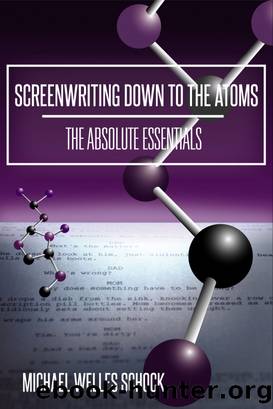Screenwriting Down to the Atoms by Michael Welles Schock

Author:Michael Welles Schock
Language: eng
Format: epub
Tags: writing, screenwriting, screenplays, storytelling, narrative theory, writing scripts
Publisher: Michael Welles Schock
MORE ON TURNING POINTS
As previously suggested, a sequence can end with one of two results. The protagonist can reach the sequence goal, or an unexpected event may force the protagonist to abandon his or her goal in favor of a new course of action.
When a sequence results in success, it creates a positive turning point. Events end on an up-beat. The knight kills the monster and saves the wizard. The knight has claimed a small victory, and can now take a moment to catch his breath before turning his attention to the next step of the plan.
However, more often than not, a sequence does not end in success. The hero is unexpectedly confronted by an insurmountable obstacle that either makes victory impossible, or throws him or her in an even more threatening situation. Let us say the knight kills the monster, only to then discover the wizard has been dead for years. This is an unexpected setback. A failure. This creates a negative turning point. The knight must now find a new course of action that will compensate for this defeat and allow him to continue onward. Or perhaps, while distracted by the monster, the knight is ambushed and captured by his enemy. This unexpected development has put the knight in an even more threatening situation. He can no longer think about the wizard. He must find a new goal and a new course of action to escape this new predicament.
If given the choice between a positive or negative turning point, it is more dramatic to go with the negative. Audiences expect the hero to succeed. Positive turning points reinforce these expectations. So, a story with nothing but positive turning points will lack the drama that comes from unpredictability. On the other hand, a swift change from bad to worse will surprise the audience. The Major Dramatic Question is then thrown into further doubt, and the audience has a new reason to fear for the heroâs welfare. For best results, use a healthy mix of positive and negative. This keeps the action unpredictable and thus more engaging for the audience.
Download
This site does not store any files on its server. We only index and link to content provided by other sites. Please contact the content providers to delete copyright contents if any and email us, we'll remove relevant links or contents immediately.
Asking the Right Questions: A Guide to Critical Thinking by M. Neil Browne & Stuart M. Keeley(5577)
Autoboyography by Christina Lauren(5155)
Eat That Frog! by Brian Tracy(4381)
Dialogue by Robert McKee(4272)
Sticky Fingers by Joe Hagan(4064)
Journeys Out of the Body by Robert Monroe(3539)
Annapurna by Maurice Herzog(3398)
Full Circle by Michael Palin(3350)
Schaum's Quick Guide to Writing Great Short Stories by Margaret Lucke(3281)
Elements of Style 2017 by Richard De A'Morelli(3280)
The Art of Dramatic Writing: Its Basis in the Creative Interpretation of Human Motives by Egri Lajos(2945)
Why I Write by George Orwell(2851)
The Diviners by Libba Bray(2841)
In Patagonia by Bruce Chatwin(2830)
The Mental Game of Writing: How to Overcome Obstacles, Stay Creative and Productive, and Free Your Mind for Success by James Scott Bell(2819)
The Fight by Norman Mailer(2802)
Atlas Obscura by Joshua Foer(2760)
Venice by Jan Morris(2496)
The Elements of Style by William Strunk and E. B. White(2416)
